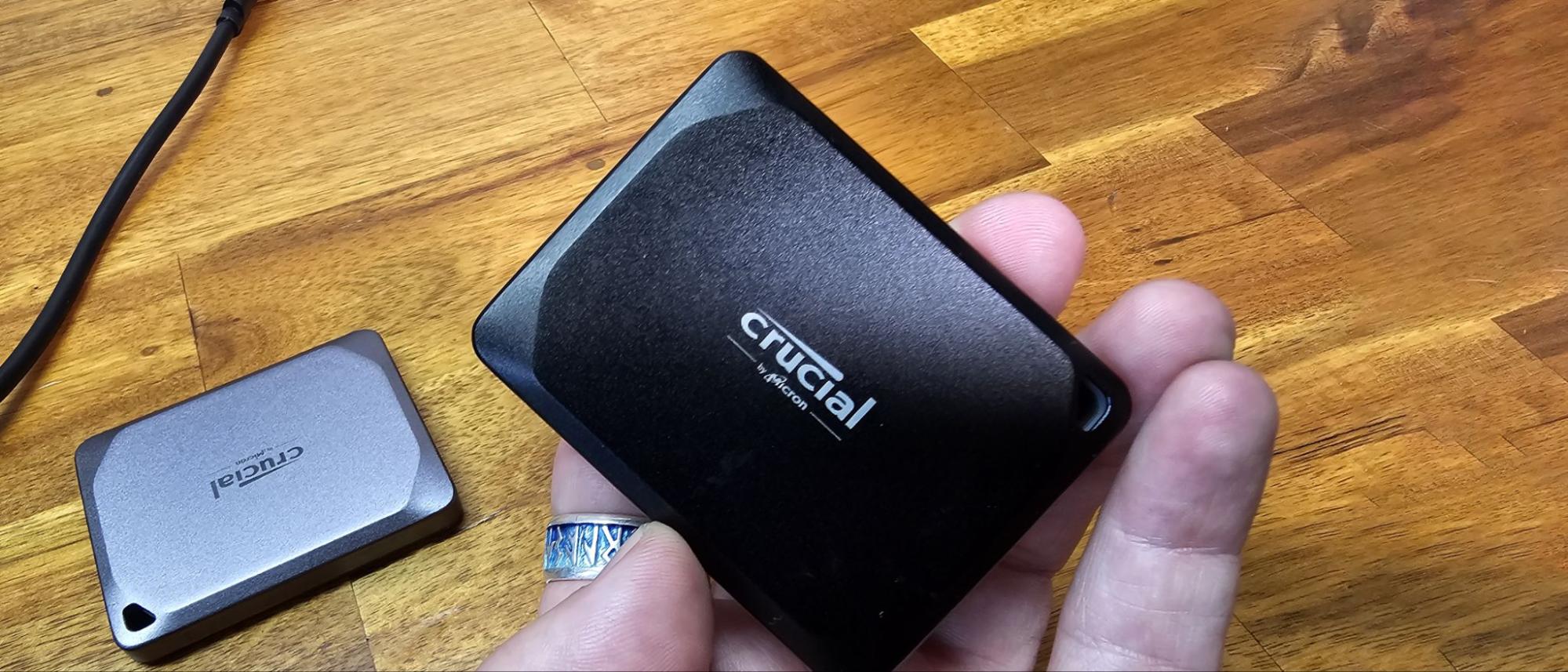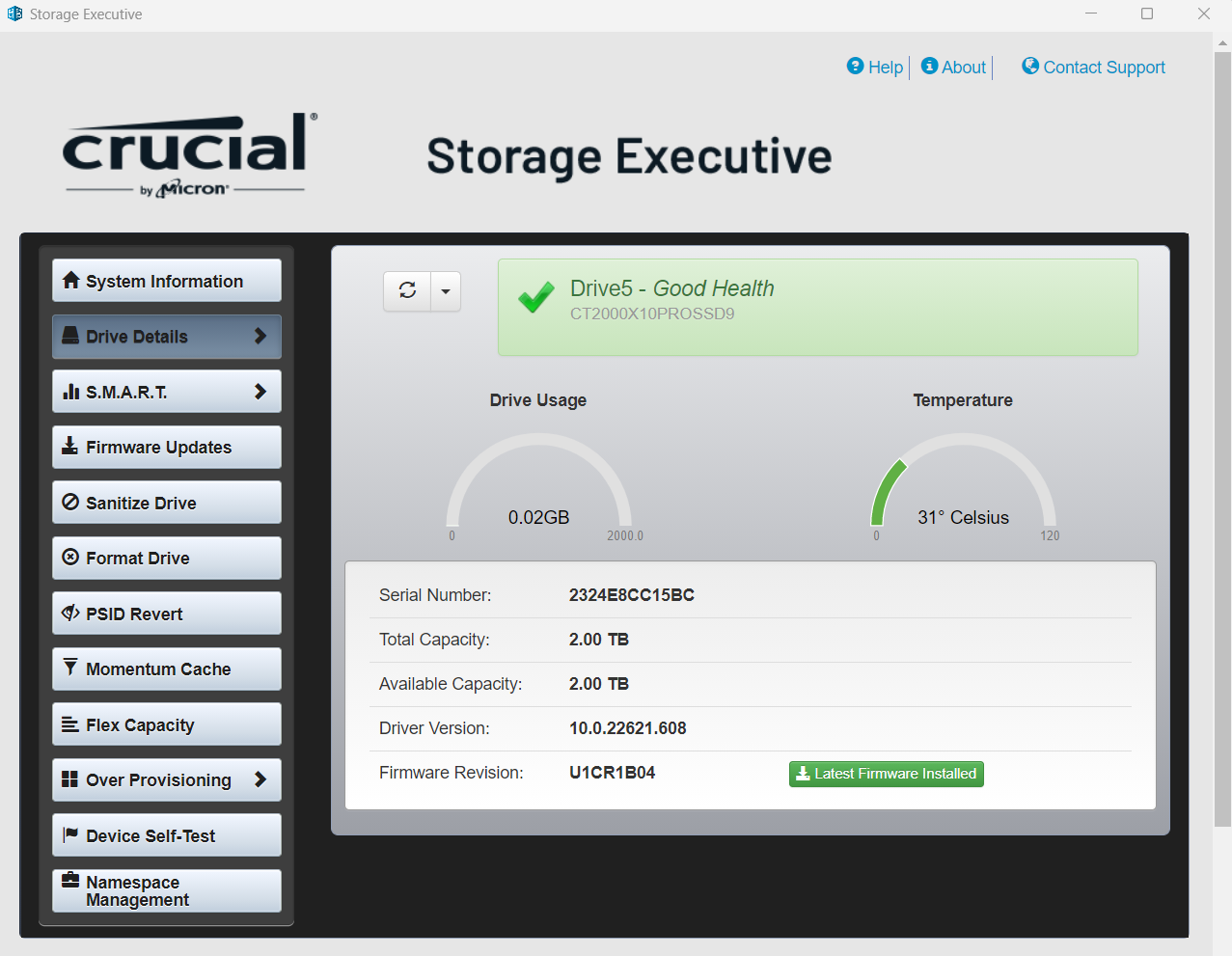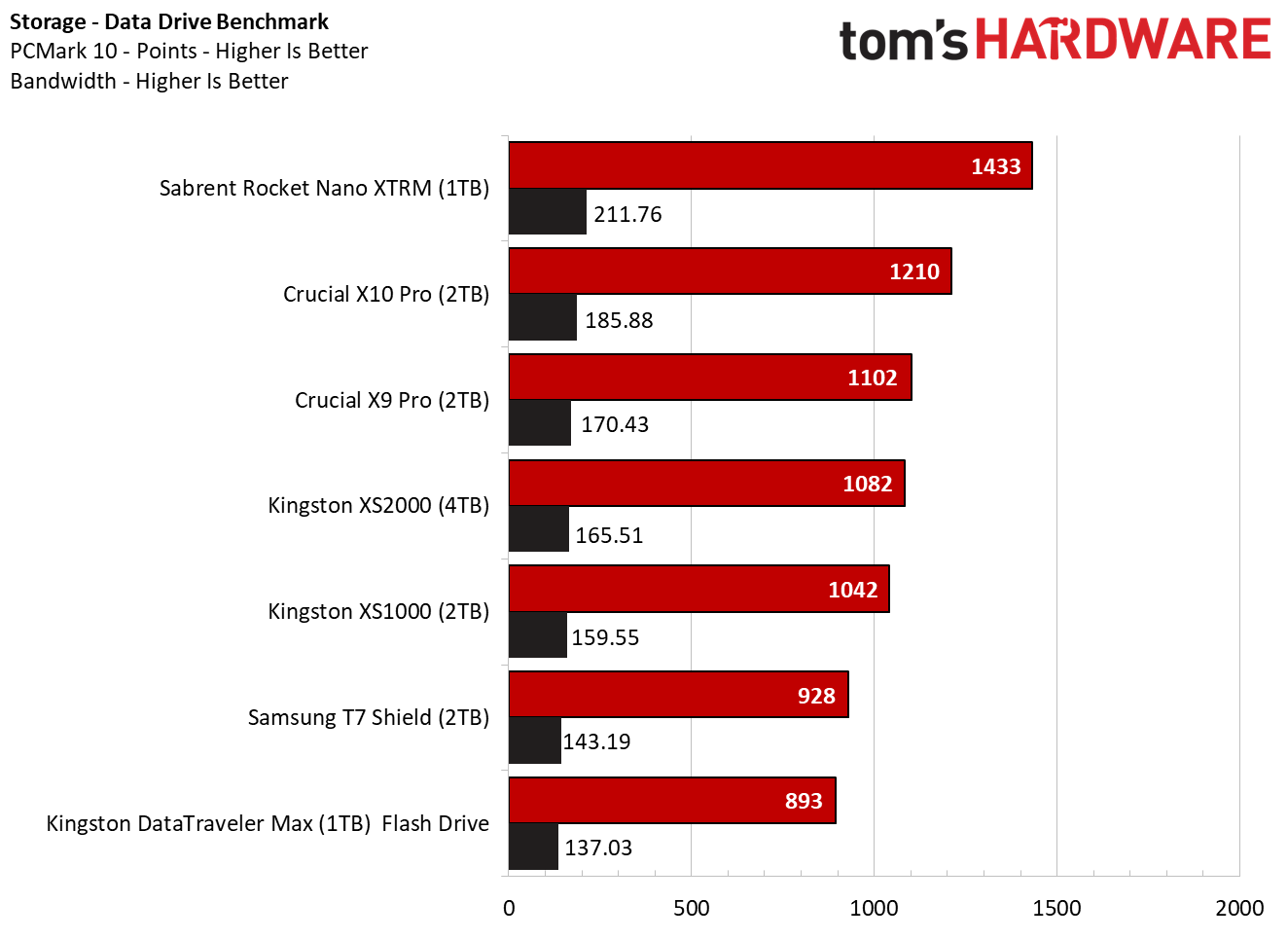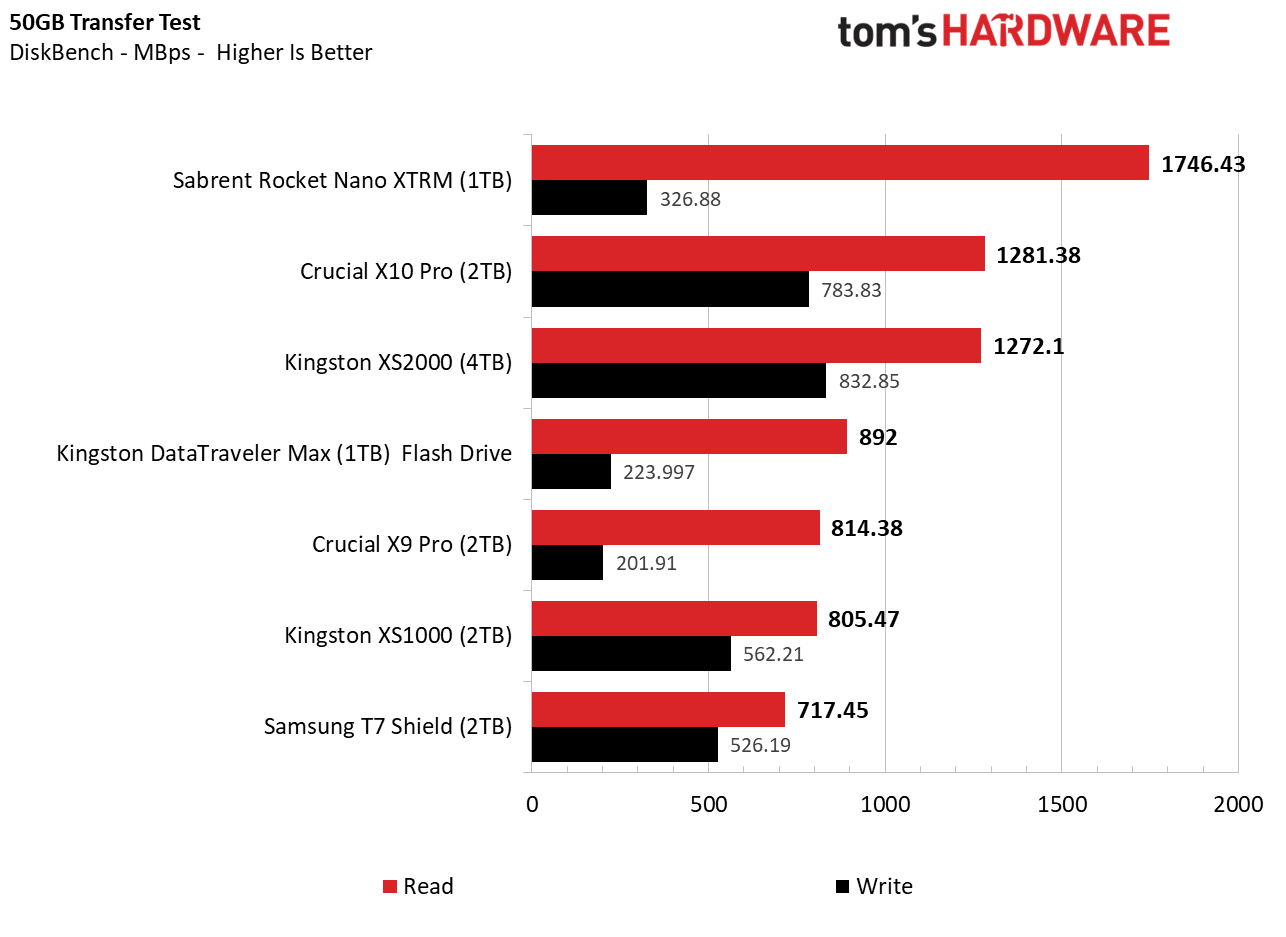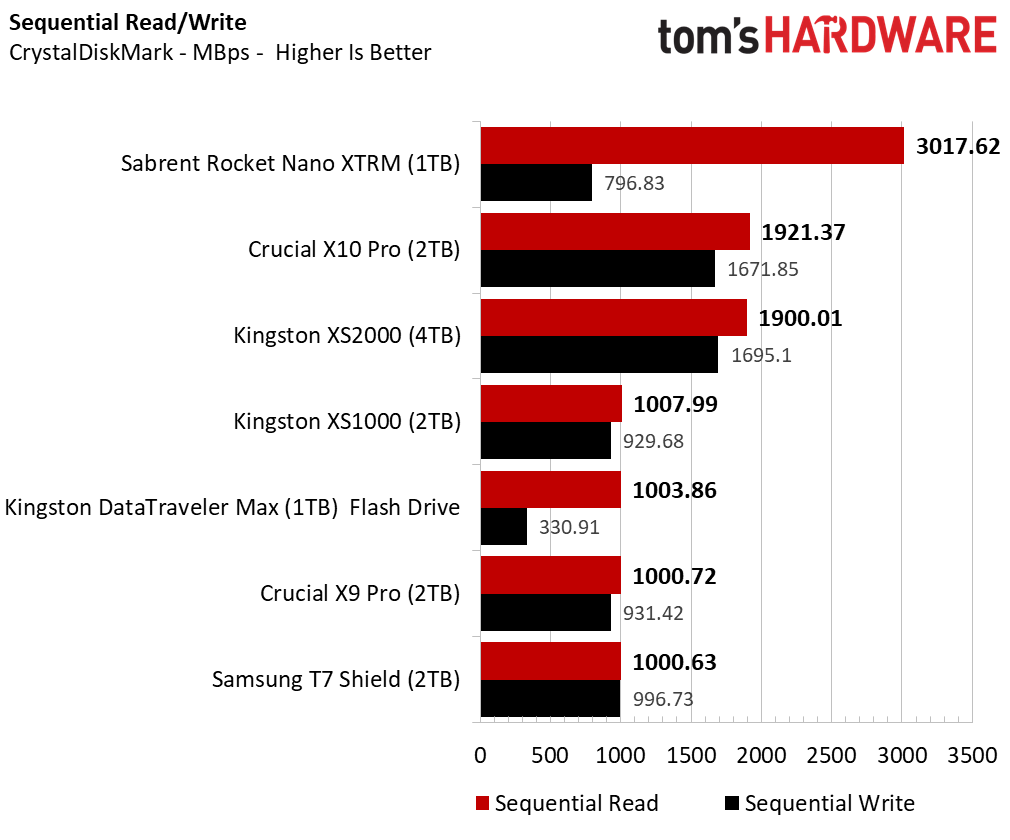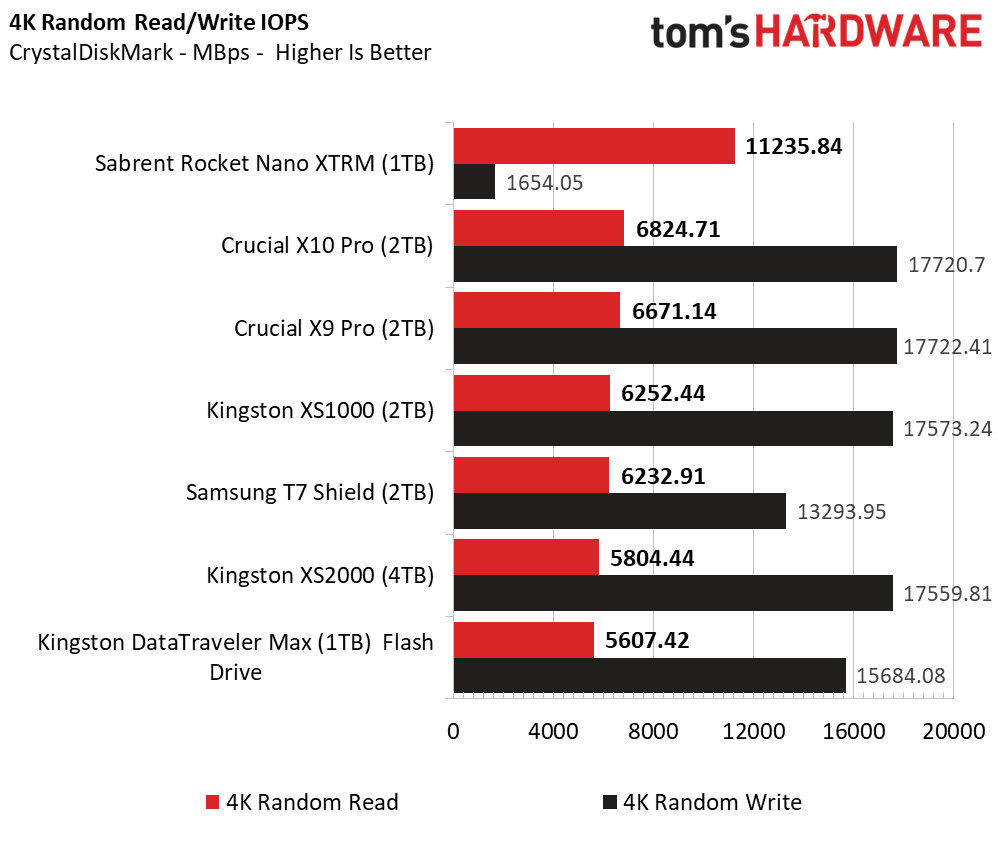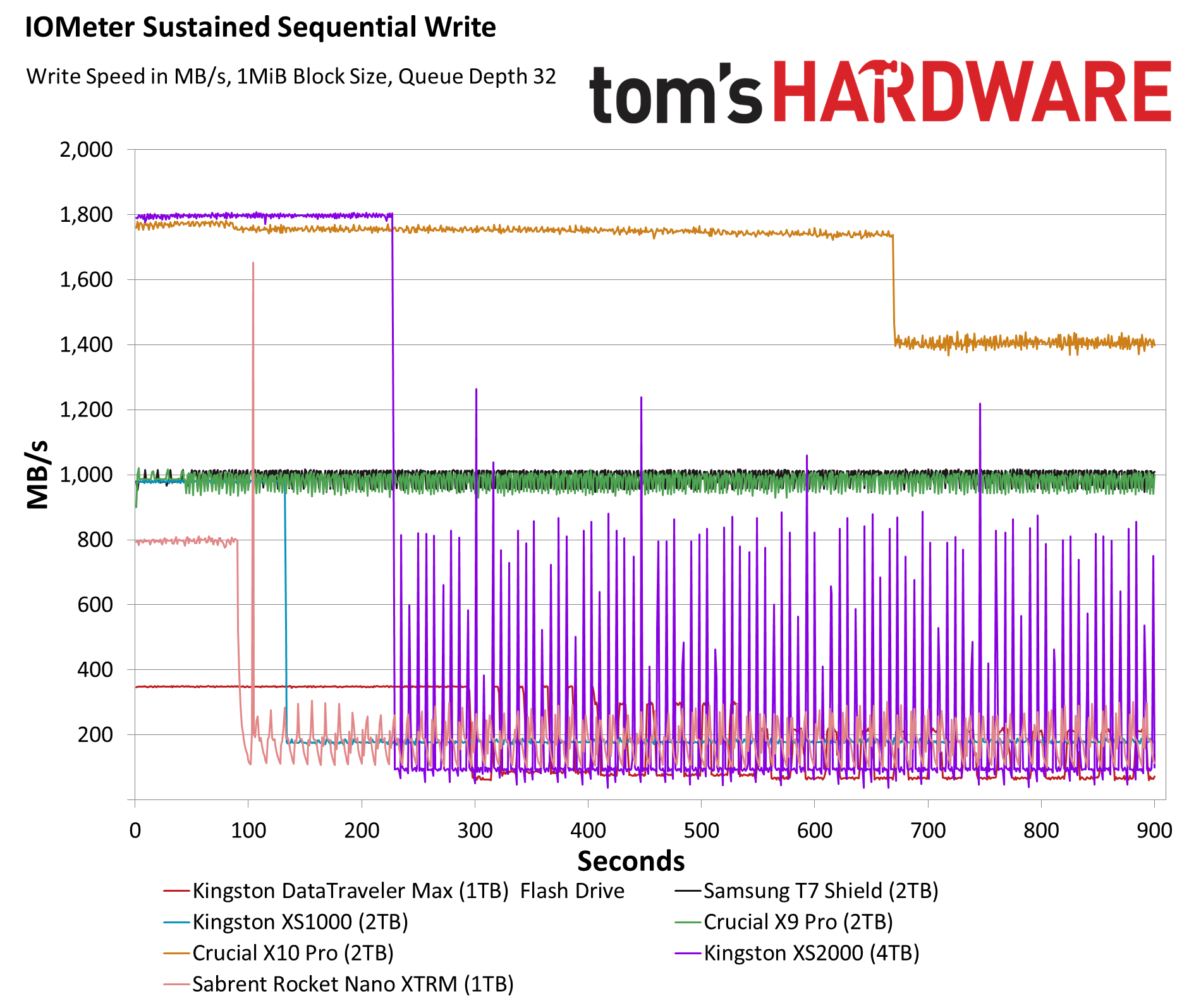Tom's Hardware Verdict
Crucial's X10 Pro is the fastest 20Gb/s SSD we've tested. Just be sure you have a USB 3.2 Gen 2 2x2 port. Otherwise, you'll be running at half speed, and should consider the X9 Pro instead.
Pros
- +
Top-notch 20Gb/s performance
- +
Compact, solid-feeling shell
- +
Reasonably priced
Cons
- -
20Gb/s USB (3.2 Gen 2 2x2) ports are pretty rare
Why you can trust Tom's Hardware
Crucial's X10 Pro SSD is the fastest USB-based external drive we've tested to date. It's also fairly aggressively priced at just over $150 for the 2TB model we tested. A 4TB option is also available for those who need more capacity (and are willing to pay more than $260 for it). The X10 Pro is also small and slim (0.39 inches thick and 2.56 inches long and 2 inches wide), with a metal shell that feels solid and premium, if a bit plain.
If you're a creator who needs to read and write huge files and you have devices with a USB 3.2 2x2 port, it's arguably the best drive you can buy. But do make good and sure your ecosystem has that port, specifically, because Thunderbolt 4 ports limit speed from a single USB drive to 10 Gb/s, which will cut the performance of this drive in half. And if you're going to be limited to 10Gb/s on all (or possibly even one) of your systems, you're probably better off opting for Crucial's also quite good X9 Pro. It caps out at 10Gb/s, but is otherwise basically the same device (clad in gray rather than black) and sells for about $40 less in the 2TB capacity.
Both of Crucial's new drives make strong plays for our best external SSDs list, especially if you can find them on sale, as they were when we wrote this review. Their performance, particularly in terms of sustained writes, is excellent. So video editors and other creators who frequently move around massive files should take particular note. Just be sure you choose the model that best fits the devices in your workflow.
| Product | 1TB | 2TB | 4TB |
|---|---|---|---|
| Pricing | 107.99 | 152.99 | 260.99 |
| Form Factor (Internal) | Single AISIC | Single AISIC | Single AISIC |
| Interface / Protocol | USB 3.2 2x2 | USB 3.2 2x2 | USB 3.2 2x2 |
| Bridge Chip(s) | N/A | N/A | N/A |
| Included | USB Type-C to Type-C cable | USB Type-C to Type-C cable | USB Type-C to Type-C cable |
| Controller | Silicon Motion SM2320 | Silicon Motion SM2320 | Silicon Motion SM2320 |
| DRAM | None | None | None |
| Memory | Micron TLC | Micron TLC | Micron TLC |
| Sequential Read | 2,100 MB/s | 2,100 MB/s | 2,100 MB/s |
| Sequential Write | 2,000 MB/s | 2,000 MB/s | 2,000 MB/s |
| Security | 256‐bit AES hardware encryption | 256‐bit AES hardware encryption | 256‐bit AES hardware encryption |
| Resistance | Shock, vibration | Shock, vibration | Shock, vibration |
| Endurance (TBW) | Unspecified | Unspecified | Unspecified |
| Dimensions | 65 x 50 x 10mm | 65 x 50 x 10mm | 65 x 50 x 10mm |
| Weight | 42 grams | 42 grams | 42 grams |
| Part Number | CT1000X10PROSSD9 | CT1000X10PROSSD9 | CT4000X10PROSSD9 |
| Warranty | 5 years | 5 years | 5 years |
Software and Accessories of the Crucial X10 Pro
Crucial ships the X10 Pro (and the X9 Pro) with a removable USB-C-to-USB-C cable that's about 6.5 inches long. If you need a USB-A cable, you'll have to provide your own. But USB-A cables with 20Gb/s of bandwidth are even rarer than USB-C ports that run at that speed. So we don't fault Crucial for shipping the X10 Pro with one kind of cable.
Crucial also offers its free Storage Executive software which, much like Samsung's Magician, lets you monitor and perform maintenance on your drive(s).
I used it during the process of this review to update the X10 Pro's firmware, and found the software to be stable, full-featured, and easy to use and navigate. It was a bit slow to launch and perform some tasks. But that could be partially down to the fact that my primary system has five internal SSDs. So it had to pull in data from six drives just to display the main System Information page at startup.
Comparison Products
We've recently set up a new storage testbed, built around an MSI Z90 MEG ACE motherboard and a Core i5-12600K CPU. This system gives us both native Thunderbolt 4 ports, as well as a USB 3.2 Gen 2 2x2 port via the front header (connected through Corsair's 5000D Airflow case).
As this is a new test rig, we have a limited amount of comparisons that will no-doubt grow quickly as we test and review more drives. In the charts below, we've included a Sabrent Rocket Nano XTRM Thunderbolt 3 drive ($170 for our 1TB). For some 20Gb/s USB competition, we've included Kingston's XS200 ($305 for the 4TB model we tested), and a trio of lower-end 10Gb/s USB drives: Samsung's T7 Shield ($120, 2TB), Kingston's SX1000 ($109, 2TB), and Crucial's X9 Pro ($130, 2TB). And lastly, for some perspective, we've also included one of the best flash drives we've tested, Kingston's DataTraveler Max (1TB, $93).
We're curious to see how the Crucial X10 Pro performs, particularly when it comes to sustained writes. This is an area where many drives quickly show their limitations, and one where Crucial claims its X10 Pro (as well as the X9 Pro) aim to impress.
Trace Testing - PCMark 10 Storage Benchmark
PCMark 10 is a trace-based benchmark that uses a wide-ranging set of real-world traces from popular applications and everyday tasks to measure the performance of storage devices.
Among the drives we've run through our new testbed, Sabrent's Thunderbolt-based Rocket Nano XTRM comes out on top here – unsurprisingly, given its higher platform bandwidth. But Crucial's X10 Pro leads the pack among USB externals, with the 10Gb/s X9 Pro not far behind in third place.
Get Tom's Hardware's best news and in-depth reviews, straight to your inbox.
Transfer Rates – DiskBench
We use the DiskBench storage benchmarking tool to test file transfer performance with a custom 50GB dataset. We copy 4,617 files (images, videos, and software ISO files) to a folder on the test drive (write). Then, after leaving the system idle for five minutes, we run the same test in reverse, moving the test folder to a different location on our PCIe 4.0 testing drive.
Here once again, the Sabrent Thunderbolt drive comes out on top, but only in reads. Crucial's X10 Pro again lands in second place in read performance, followed by the other 20 Gb/s USB drive here, Kingston's XS2000. The Kingston drive did better on writes, but the X10 Pro edged it out in read speeds.
Synthetic Testing CrystalDiskMark
CrystalDiskMark (CDM) is a free and easy-to-run storage benchmarking tool that SSD companies commonly use to assign performance specifications to their products. It gives us insight into how each device handles different file sizes. We run this test at its default settings.
We see a similar pattern here when we look at sequential read speeds, though once again it falls behind on writes. The two 20 Gb/s USB drives land again in second and third, with the Crucial X10 Pro leading in read speeds and the Kingston XS2000 ahead on writes.
When it comes to random writes/IOPS, we see the limitations of the Sabrent drive at its starkest. While the Rocket Nano XTRM nearly doubles the competition in reads, it lags behind most of the competition in small file writes by more than a factor of 10. Both Crucial drives, meanwhile, are effectively tied for first place in small file writes, and the X10 leads the X9 (and everything else save for the Thunderbolt drive) in reads. This is a solid showing for both Crucial drives.
Sustained Write Performance
A drive's rated write specifications are only a piece of the performance picture. Most external SSDs (just like their internal counterparts) implement a write cache, or a fast area of flash, programmed to perform like faster SLC, that absorbs incoming data. Sustained write speeds often suffer tremendously when the workload saturates the cache and slips into the "native" TLC or QLC flash. We use Iometer to hammer the SSD with sequential writes for 15 minutes to measure both the size of the write cache and performance after the cache is saturated.
In this, the most grueling of our storage benchmarks (and the kind of workload a drive like this is designed for), Crucial's X10 Pro did extremely well. It hovered mostly between 1750 and 1780 MB/s for just over 11 minutes, before dropping down to the 1400 MB/s range, which is still faster than the vast majority of competing drives at their fastest write speed.
The Thunderbolt-based Sabrent drive is slightly faster out of the gate, but becomes much slower (and much more erratic) after less than four minutes. The Crucial X10's showing here proves it's a good fit for content creators who need to move large files around with minimal waiting – provided you have devices with USB 3.2 Gen 2 2x2 ports.
The 10Gb/s-limited X9 Pro is no slouch here either. It delivered a fairly steady write speed throughout the duration of the test, averaging 983MB/s, which was just behind Samsung's T7 Shield, which averaged 994MB/s.
Test Bench and Testing Notes
| CPU | Intel Core i5-12600KF |
| Motherboard | MSI Z790 MEG ACE |
| Memory | 2x16GB Corsair Dominator Platinum DDR5 6400 CL38 |
| Graphics | Gigabyte GTX 1080 TI |
| CPU Cooling | Corsair H150i RGB (360mm) |
| Case | Corsair 5000D Airflow |
| Power Supply | Corsair RM850x Shift |
| Storage | Samsung 980 Pro 1TB |
| Operating System | Windows 11 Pro |
We use an Intel Alder Lake platform, with most background applications such as indexing, windows updates, and anti-virus disabled in the OS to reduce run-to-run variability.
Conclusion
For those who work with large files, who can take full advantage of its USB 3.2 Gen 2 2x2 interface, Crucial's X10 Pro is the fastest USB drive we've tested. It was also quite reasonably priced when we wrote this, at $170 for the 2TB model we tested. That, combined with solid software and a nice compact, metal-clad shell makes it easy to recommend.
Just make sure, though, that you have the right ports to take full advantage of its speed. If, like most people, you have a system with Thunderbolt or 10Gb/s USB, there are drives that will perform similarly for less money. Crucial's 10Gb/s X9 Pro, for example, is currently $130 for 2TB, or $40 less than the speedier X10 Pro.
MORE: Best External SSDs
MORE: Best SSD for the Steam Deck
MORE: How We Test HDDs And SSDs
After a rough start with the Mattel Aquarius as a child, Matt built his first PC in the late 1990s and ventured into mild PC modding in the early 2000s. He’s spent the last 15 years covering emerging technology for Smithsonian, Popular Science, and Consumer Reports, while testing components and PCs for Computer Shopper, PCMag and Digital Trends.
